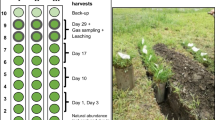Abstract
The release of non-exchangeable (fixed) NH +4 and the importance of exchangeable NH +4 at transplanting (initial exchangeable NH +4 ) for rice (Oryza sativa L.) growth was studied in representative lowland rice soils of the Philippines.
The experiments showed that initial exchangeable ammonium behaved like fertilizer N and thus may serve as a valuable guideline for nitrogen fertilizer application rates when calculated on a hectare basis. By using the15N tracer technique it was found that nonexchangeable ammonium in soil may contribute to the nitrogen supplying capacity of lowland rice soils. Fixation and release of NH +4 seem to be more dependent on the form of clay minerals than on clay content. In soils rich in vermiculite non-exchangeable ammonium should be considered together with other available N sources such as exchangeable ammonium for N fertilizer recommendations for lowland rice.
Similar content being viewed by others
References
Broadbent FE and Nakashima T (1970) Nitrogen immobilization in flooded soils. Soil Sci Soc Amer Proc 34:218–221
Broadbent FE and Tusneem FE (1971) Losses of nitrogen from flooded soils in tracer experiments. Soil Sci Soc Amer Proc 35:922–926
Bremner JM (1965) Inorganic forms of nitrogen. In C.A. Black ed Methods of soil analysis. Amer Soc Agron, Madison, Wisconsin: 1179–1237
Dahnke WC and Vasey EH (1973) Testing soils for nitrogen in Walsh LM and JD Beaton Soil testing and plant analysis. Soil Sci Soc Amer, Madison, Wisconsin:97–115
Faust H (1969) Optical spectroscopy technique for N-15 assay. IAEA/FAO. Res. coord. meeting on recent development in the use of N-15 in soil-plant studies, Sofia, Bulgaria
Fox RH and Pickielek WP (1978) A rapid method for estimating the nitrogensupplying capacity for a soil. Soil Sci Soc Amer J 42:751–753
Harwood JE and Kuhn AL (1970) A colorimetric method for ammonia in natural waters. Water Res 4:805–811
Keeney DR and Bremner JM (1966a) A chemical index of soil nitrogen availability. Nature, 211:892–893
Keeney DR and Bremner JM (1966) Determination and isotope ratio analysis of different forms of nitrogen in soils. 4. Exchangeable ammonium, nitrate, and nitrite by direct distillation methods. Soil Sci Soc Amer Proc 30:583–594
Keerthisinghe G, Mengel K and De Datta SK (1984) The release of non-exchangeable ammonium (15N labelled) in wetland rice soils. Soil Sci Soc Amer J 48:291–294
Kerbs LD, Jones JD, Thiessen WL and Parks FP (1973) Correlation of soil test nitrogen with potato yields. Comm. in Soil Science and Plant Analysis 4:269–278
Kowalenko CG and Ross GJ (1980) Studies on the dynamics of ‘recently’ clay fixed NH +4 using15N. Can J Soil Sci 60:61–70
Martin AE, Gilkes RJ and Skjeemstad JO (1970) Fixed ammonium in soils developed on some Queensland phyllites and its relation to weathering. Aust J Soil Res 8:71–80
Mengel K and Scherer HW (1981) Release of non-exchangeable (fixed) soil ammonium under field conditions during the growing season. Soil Sci 131:226–232
Mohammed IH (1979) Fixed ammonium in Libyan soils and its availability to barley seedlings. Plant and Soil 53:1–9
Opuwaribo E and Odu CTI (1974) Fixed ammonium in Nigerian soils. I. Selection of a method and amounts of native fixed ammonium. J Soil Sci 25:256–264
Savant NK and De Datta SK (1982) Nitrogen transformations in wetland rice soils. Adv Agron 35:241–302
Schön HG (1982) Die Bedeutung des austauschbaren Ammoniums in überfluteten Reisböden für die Ertragsbildung von Reis und für die Basis einer Stickstoffdüngerempfehlung. Ph D thesis, Fac of Nutrition, Justus Liebig-University, Giessen
Scott AD and Smith SJ (1966) Susceptibility of interlayer potassium in micas to exchange with sodium. Clays and Clay Min Proc 14th Nat Conf 69–81
Silva JA and Bremner JM (1966) Determination and isotope-ratio analysis of different forms of nitrogen in soils. 5. Fixed ammonium. Soil Sci Soc Amer Proc 30:587–594
Sims JR and Jackson GD (1971) Rapid analysis of soil nitrate with chromotropic acid. Soil Sci Soc Amer Proc 35:603–606
Sippola J, Ervio R and Eleveld R (1973) The effect of simultaneous addition of ammonium and potassium on their fixation in some Finnish soils. Ann Agriculturae Fenniae 12:185–189
Smith JA (1966) An evaluation of nitrogen soil test methods for Ontario soils. Can J Soil Sci 46:185–194
Soper RJ and Huang RM (1963) The effect of nitrate nitrogen in the soil profile on the response of barley to fertilizers nitrogen. Can J Soil Sci 43:350–358
Walsh LM and Murdock JT (1963) Recovery of fixed ammonium by corn in greenhouse studies. Soil Sci Soc Amer Proc 27:200–204
Wehrmann J and Scharpf HC (1979) Der Mineralstoffgehalt des Bodens als Maßstab für den Stickstoffdüngerbedarf (Nmin-Methode). Plant and Soil 52:109–126
Author information
Authors and Affiliations
Rights and permissions
About this article
Cite this article
Mengel, K., Schon, H., Keerthisinghe, G. et al. 6. Ammonium dynamics of puddled soils in relation to growth and yield of lowland rice. Fertilizer Research 9, 117–130 (1986). https://doi.org/10.1007/BF01048698
Issue Date:
DOI: https://doi.org/10.1007/BF01048698




